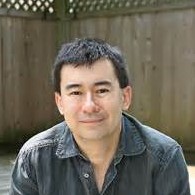Issue 8 of Superstition Review is packed with talented artists and writers. Here are a few highlights:
Art
New England artist Paul Chojnowski creates vivid images not with pencil or paint, but with fire. His “fire drawings” are detailed images made by burning, scorching and sanding the surface of paper or wood. Take a look at “After the Deluge” to see how Chojnowski burned and scorched a piece of maple veneer into a beautiful image.
Ready to let your imagination go to work? Check out the work of Rafael Francisco Salas. Salas’ bio states that he uses “landscape along with narrative and symbolic elements [to] create artworks that investigate the nature of nostalgia, memory and dreams.” In Untitled (Funeral), we see a funeral scene, but the casket is obscured by . . . something. This is where your imagination comes in. What does your brain interpret the something to be—a ghost, a dream, a memory?
Fiction
How’s this for a first sentence – “My son was born under the carob tree, and all three fathers were there to greet him.” Three fathers? You’re interested, aren’t you? Read Eric Maroney’s “Grow, Grow” and you will not only learn how this first sentence is possible, you’ll realize this is a beautiful story of hope.
If all the world’s a stage, and all the men and women merely players, then we’re all stars of our own reality show or prime time TV drama. Eugenio Volpe explores this theme in his short story “Low Lives.”
Interviews
A peek into a writer’s brain can be just as entertaining and enlightening as reading their work. SR interviewed many fascinating writers this fall, including Darrin Doyle and Madison Smartt Bell.
In his interview, Doyle discusses how he creates the vivid images in his stories and talks about the difference between writing a short story and a novel (teaser – it has something to do with pregnancy).
Bell shares where he gets his inspiration (daemons: just read the interview) and what he is currently working on; a biography of Jean-Jacques Dessalines, first Emperor of Haiti, a romance, and a story about zombies. Real ones, though, not the movie kind.
Nonfiction
“Walking Sophie” is about kinderwagons, pollution, and Winston Churchill. How do these all fit together? Follow James Valvis on his daily trek with his infant daughter to the mailbox and the park and even further through the many emotions of rejection, endurance and what it means to be a father.
“I’ve never seen the top of my head.” How would you respond to the statement? Patrick Madden muses over this pronouncement from his daughter and other subjects in his set of essays “Contradiction: Poetry,” “Contradiction: Insanity,” and “Contradiction: Memory.”
Poetry
Ever lose part of a savannah? Misplaced a volcano? Read Karen Skolfield’s “Lost Mountain” to see if maybe you have.
“I Sit in on a Special Education Lesson” by Yu Shibuya shows how poetry can take an everyday occurrence and find the complexity of emotions that exist under the surface. Read this poem. You will not be disappointed.
Nor will you be disappointed with any of our other talented contributors to Superstition Review Issue 8. Now, go—look, read, repeat.
